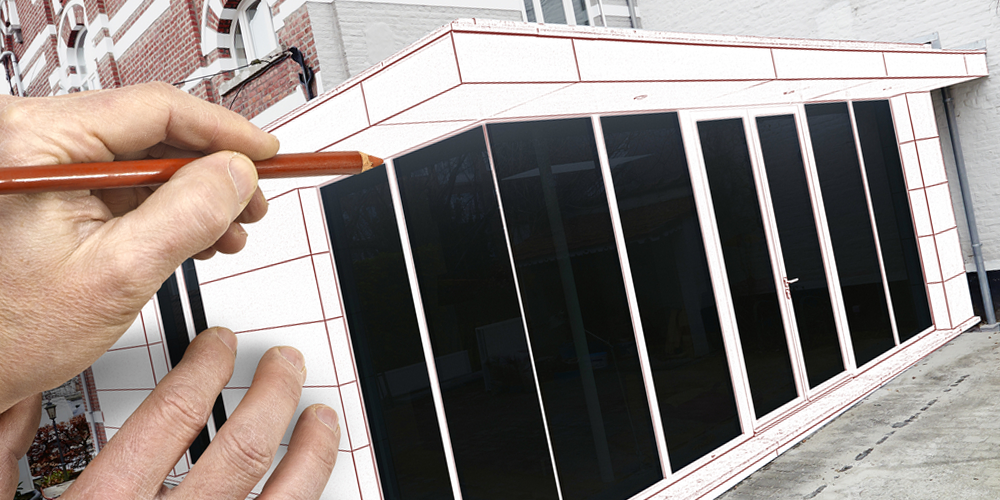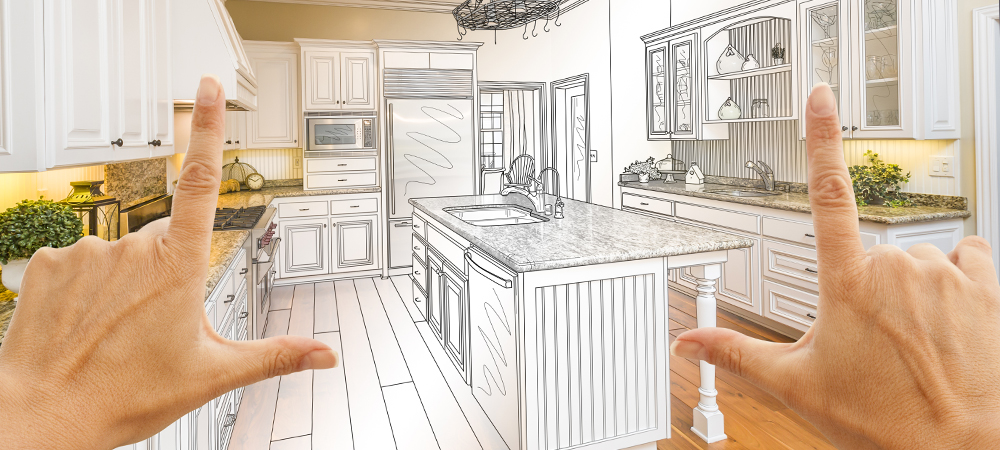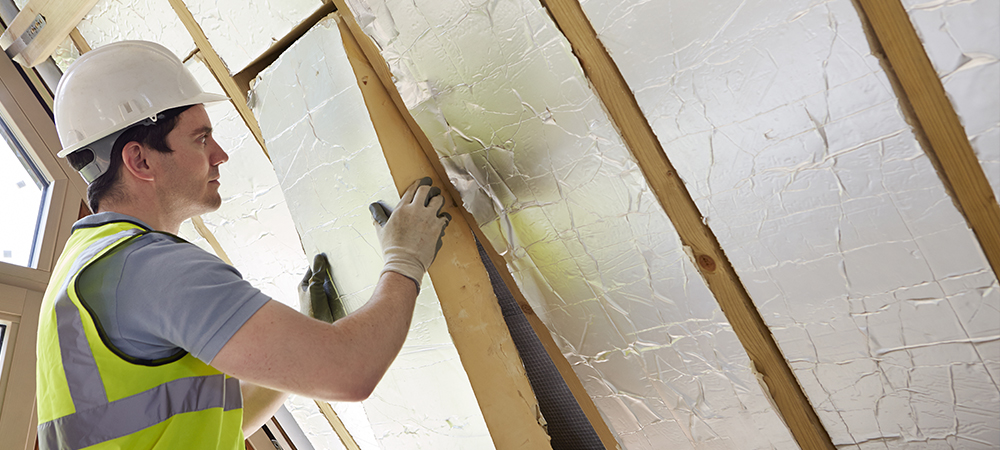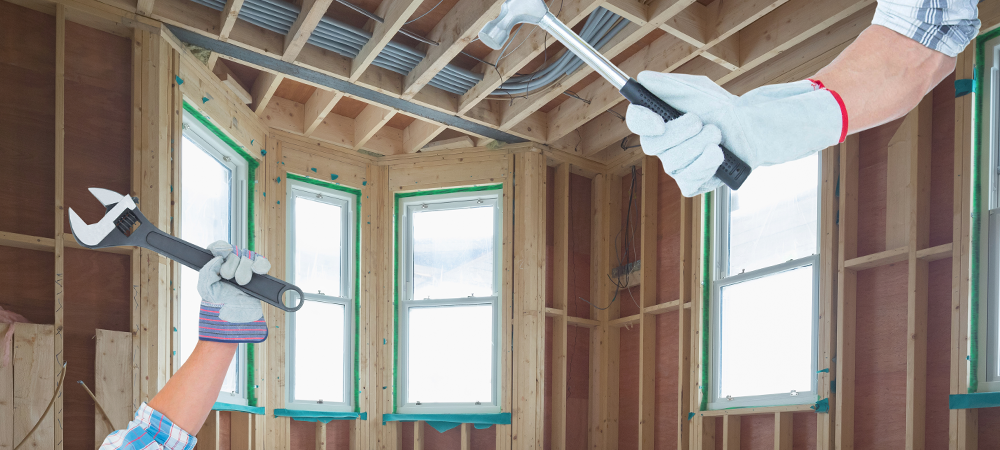
Want to extend your home, or a property that you are planning to buy? Here's how to do it without having to submit a planning application.
Permitted development rights enable homeowners to make certain building works on a property without planning permission from the local council and without approval from a neighbour.
The rules were originally brought in as a temporary measure in 2013, but they have recently been made permanent.
If you are in the process of buying a property (to live in or rent out), this means you have a number of rights to extend or change it after you have completed the purchase.
If your property is semi-detached or terraced, you can add a single-story rear extension of up to six metres. For detached properties, the limit is eight metres. Extensions cannot cover more than half of the land surrounding the original house and materials should be of similar appearance. The rules do not apply to flats, maisonettes or other types of buildings and do not apply to balconies, verandas and platforms (above 30cm).
Before you proceed, it's essential that you check with your local planning authority first. Permitted development rights should provide you with automatic planning permission for:
- Small extensions
- Single storey extensions
- Double storey extensions
- Demolition
- Loft conversions (under 40 cubic metres)
- Garage conversions
- Basement conversions
When might the rights be restricted?
If your property is within a conservation area, a National Park, an Area of Outstanding Beauty, a World Heritage Site or the Norfolk or Suffolk Broads, you will need to apply for planning permission.
Planning dream home? What else can you do to get around the planning laws?
If your property lies within an isolated location and your renovation plans can be considered 'truly outstanding or innovative, reflecting the highest standards in architecture', under paragraph 79 of the National Planning Policy Framework, you could get planning permission, where standard permissions would not be granted. A number of spectacular properties have been developed using this clause. But be warned! Planning consent for such projects is hard to achieve and you are best advised to select an architect and planning consultant that has experience of and success with Paragraph 79 projects.

Historically, the Christmas and New Year holidays see record visits to sites such as Rightmove and Zoopla, with over 1.6m properties viewed online as people escape the Christmas turkey to think about their next move.
Understandably, many people are reluctant to sell or let their property until after the New Year. But, if you are thinking of moving, selling or letting a property in January, can you afford not to put your property in front of potential buyers at this important time of year?
Even if your property is listed with an agent, you don't have to conduct viewings, if you don't want to. The likelihood is that potential buyers or tenants would prefer to wait until the New Year anyway. Instead, get your property listed, so you're ready to take action as soon as the holiday season is over.
Here's what we recommend:
- Book your market appraisal now. We can discuss with you a strategy to get your property in front of buyers or tenants by the 21st December, so that your listing is available for all those buyers researching over Christmas.
- Get your home ready for selling. Use your preparations for Christmas as a time to de-clutter and to fix those DIY jobs.
- Get your paperwork in order. Get your payslips, bank statements, tax returns and employment contracts together, so you are ready to apply for your next mortgage, demonstrate that you have the funds in place for your next property or be able to quickly complete the tenant application process.
- Get a surveyor lined up to complete a survey on your property. Unless you are buying a new property, which will come with all or some of a 10 year NHBC guarantee, chances are that you will need some form of survey completing on your next property. Use the run-up to Christmas to decide who you are going to use and what type of survey you are going to undertake.
If you are thinking of selling or letting before or just after Christmas, planning ahead will ensure you get a head start in the New Year, will ensure your property is in front of potential buyers over the Christmas break and still enables you to enjoy family time without disruption. Voila!
Get in touch today, if you'd like to arrange a free market appraisal of your property.

Thinking of downsizing? What are your options?
There could be a host of reasons for you to consider downsizing. Your kids may have flown the next, your garden may be too large, you may want to release some equity, reduce your monthly outgoings, or you are simply drawn to living in a smaller, more manageable property.
Downsizing isn't just for retirement. It can be an important choice at any stage of your life, location, health or wealth. Whatever your reasons, whether you are a homeowner, a private tenant, living in a council or housing association accommodation, it's important to review the options before making your decision.
House downsizing or garden downsizing?
It's an important distinction. Is your motivation to reduce your living space? Or simply to reduce the size of your garden? Or both! If you are used to having a garden how would you feel about having a property without one? If having your own outdoor space is important, most flats would be unsuitable, unless you'd be happy with a green public area nearby? If you have a large garden, could you sell or rent it whilst keeping your existing property?
Where do you want to move to?
How far away from friends and family do you want to be? Moving nearer the grand kids may have it's attractions, but will you miss your friends and neighbours?
What facilities need to be close by? Do you want to be in the centre of a bustling city or in the leafy suburbs? Do you want to be closer to shops or restaurants? Or within walking distance of your GP? Do you need to be near public transport? Are taxis readily available if needed?
What property features will meet your needs?
One of the biggest stumbling blocks of downsizing is having to compromise on room dimensions. When viewing properties, think carefully about how you will use the available space. Do you need a permanent spare room? Or could a larger living room or study become a multifunctional space with sofa beds for when guests stay over. Is accessibility an issue?
Start by drawing up a list of all the important features you need in your next property and rank them by priority. Don't forget that your future needs may be different from today.
Renting, even if only initially, could be an important option for you. Giving you time to evaluate different types of property and locations before deciding where to settle and what for.
Will downsizing help you achieve your financial goals?
Downsizing may not actually end up being cheaper. Before you take the plunge make sure you've considered all the hidden costs. Such as; the costs of moving, council tax in your new location, travelling expenses, insurance premiums as well as utilities costs for properties with lower EPCs etc
You may find that there are cash incentives for downsizing. If you currently rent a council or housing association property you may be encouraged to free up your property for a larger family. There are also housing exchange schemes and relocation schemes encouraging people to relocate to seaside towns. Take a look at: houseexchange.org.uk and housingmoves.org for more information.
Learning to let things go.
Almost certainly, downsizing will mean that you will have to let go of long held furniture and possessions that may be been accumulated over many years. It needn't be a painful process. People that have successfully downsized say they came to a realisation that they didn't need lots of possessions to lead a happy life. In fact, de-cluttering can be quite liberating!
If you need any help in evaluating your options, give us a call today.

1. What's your budget?
Think hard a carefully about how much you want to spend. It's easy to get carried away with that better and more attractive property, but don't forget you also have bills to pay when you move in! You might also consider renting as a short term option whilst you're saving a deposit. In which case, set you budget sensibly and you'll have more available to save each month.
If you have a family and need four bedrooms, you will almost certainly have to pay a premium for a garden and extra living space. Whilst, if you’re searching for a one bedroom flat close to central London and your budget is only £1,000 /month, then you may need to widen your geographical search!
As with life, searching for a rental property may include having to make compromises.
2. What do you actually need?
If you’re living alone, or you have a large family with kids and a dog, your needs will be different. Your choice of rental property needs to complement your lifestyle. Draw up a list of the most important aspects you are looking for and be aware that you might not find exactly what you’re looking for.
Make sure you are clear about your priorities. A second bedroom might be useful, but would you actually prefer a garden?
3. Where do you want to live?
The old adage 'location, location' is equally true when renting a property. You may have your heart set on a specific area because you know it well or because you have friends or family nearby, but it’s always worth keeping an open mind and letting your budget drive your search.
If your monthly budget only allows you to rent a one bedroom flat in area of choice, you might want to consider a two bedroom apartment slightly out of area. Especially if it affords you more space and saves you money.
4. Register with Rightmove, Zoopla and local agents
Online portal such as Rightmove and Zoopla are a great way to start your property search.
However, be aware that some properties are rented out before they even get listed online, so it’s worth registering with a local estate agent who will help you find properties as soon as they become available.
5. Get viewing!
Unless you are very confident that your first property viewing is 'the one', it's worth viewing several properties so that you get a feel for what's available. Be realistic in your search. The prefect property may not exist. When you have a clearer view about what you want and you find one that 'nearly perfect', don't umm and ah! Rental markets can often be competitive and chances are the property is already being eyed up by someone else.
6. Making an offer
When you’ve found a property you are happy with, put your offer into the agent straightaway. You might get away with an offer that’s lower than the asking price but be prepared to go higher, especially if you are up against other offers. To maximise your chances of getting the property, we'd recommend making an offer as close as possible to the asking price. If you're in a competitive bid, be creative about your offer. You could offer the asking price with an extended term for example. This might be more attractive to the landlord than a slightly higher offer for the minimum term. The date you can move in may also affect the chance of your offer being accepted, as no landlord wants a property to be empty for a couple of months after it first becomes available. Agreeing to the lease from day 1, might put you in a better position than another prospective tenant, even if that means an overlap with your current accommodation. Don't forget, when you're negotiating with the agent, now is the time to make any requests to the landlord about anything you would like to change.
7. Paperwork, paperwork
It's always preferable to get your paperwork together in advance of making an offer. It will be less stressful for you and will avoid any holdups in the process. Here's what you will typically need:
- Some form of photographic ID. You will need to present this to the agent in person
- Proof of address
- Completing a Right to Rent check in branch
- Bank statements from the past three months
- Reference from your current landlord/character reference
- Reference from your employer
- Possibly a guarantor reference
The documentation will need to be approved by the landlord.
8. Sign the contract and pay your deposit
Whilst the paperwork is being prepared you will need to pay your deposit and the first month’s rent. You will also need to sign the tenancy agreement, which is the contract in which you formally agree to rent the property. Your landlord will also sign the tenancy agreement and, at this time you should also raise any questions or concerns you may have. Future rent collections will probably be by standing order, so that may need setting up too.
9. Moving in…
When the paperwork is in place and your deposits have been paid, it’s finally time to move in! The keys for your new rental home will be available on the day your tenancy starts, so you'll need to plan removal companies / other modes of transport around when you’re able to collect the keys from your estate agent.
An inventory will also be prepared for your new property, possibly on the day you move in. It's a good idea to request a copy. In addition, we'd recommend that you take your own notes / photographs, detailing the condition of the property on the first day. If there's anything that has the potential to cause a dispute in the future take a photograph of it and ask the agent / landlord to put it right.
10. Relax & enjoy!
Once you've moved in, relax! Congratulations and enjoy your new home!

With temperatures continuing to soar and the outlook for this to remain throughout the Summer, it's more important than ever to keep cool indoors. Take a look at our survival guide to keep your cool at home…
1. Shut the windows.
It may feel counterintuitive, but throwing open the windows to the sun is a sure-fired way to make your house feel like a sauna. Instead, try shutting the windows and closing the blinds (or curtains) and your rooms will instantly feel cooler. Consider thermal blinds, solar sun screens and window film for maximum effect. Make sure you only open windows when the heat has died down and the air is cooler outside.
2. Create a through draft.
If you really want to keep the windows open, make sure you open windows across opposite sides of your home; allowing air to travel from the front to the back of the house. You might have to position furniture to stop doors and windows slamming!
3. Invest in a fan.
There are a huge range of fans and air-conditioning units available, from inexpensive ones at just a few pounds to expensive devices with a host of cooling features. The key is to use them strategically to get the air moving. Point them towards an open window to push the air out or to create a cross wind across your home. You can also place a bucket of ice in front of the fan to help cool the air.
4. Use 'breathable' bedding.
Now is not the time to sleep in silks, satins and polycottons. Instead opt for breathable 100% cotton sheets or light coloured linens to help you keep cool.
5. Sleep on the ground floor
Not all of us have the luxury of choosing where to sleep at night. But, as heat rises, if you can locate your bedroom on a lower floor you should have a more comfortable nights sleep compared to a hot attic bedroom.
6. Turn off electrical appliances
It may seem obvious, but electrical appliances radiate heat. Instead of using your oven or hob to cook, why not use a barbeque outside instead? If you need an excuse not to use the dishwasher, washing machine or tumble dryer! Now is the perfect time! Switch off as many appliances as you can, to help keep your home cooler. When you need to turn on the lights, consider low-heat CFL lightbulbs and dry your washing outside instead .
7. Use less hot water
Hot showers create excess heat and humidity. Turn the temperature down and it will help keep you cool. Taking shorter showers also help to reduce humidity.
8. Use your hot water bottle
Hot water bottles are great in the winter, but did you know that you can also fill them with water and then freeze them? Fill your hot-water bottle with cold water and pop it into the freezer. It'll create a lovely ice pack to keep you cool!
9. Paint it white!
This may not be a solution for today! But when planning your home interior and exterior colours! Go for cooling whites and soft greys instead. The cooler colours will help reflect the light, helping to cool your house down, and also create a lovely calming environment.
10. Insulate
Again, this isn't a solution for today. But insulation, more commonly known in the UK for its heat retention properties, is also a great way to keep the heat out. A well insulated house is warmer in the winter and cooler in hot summers.

You will almost certainly have read about technological advances relating to driverless cars, flying taxis and hyperloops (a mode of transport that propels a pod at speeds of up to 760mph). Whilst these offer the tantalising prospect of alternatives to commuting on congested road networks, the most common futuristic tools you are likely to come across are available as smart upgrades to your home.
Smart-home upgrades can also help you sell or let your property…
The most popular ones can be quickly, easily and affordably be installed to help you differentiate your property from others on the marketplace:
- Replace thermostats with smart models which enable you to control your property’s temperature by voice control and geofencing (the ability to adjust the temperature as you leave and return home)
- Install smoke and carbon monoxide detectors. Providing peace of mind, smart detectors can send alerts to your phone and even tell you when the battery is running low.
- Add warm glow smart lightbulbs. By swapping out old lightbulbs with smart LEDs connected to a control hub you can control your lighting over the internet. Turn your lighting on (or off) before you arrive home and change the mood by changing the brightness and even colour of the lighting.
- Keyless locks and video doorbells. Improve the security of your property with smart door locks that use smartphone apps, key cards and tags to provide bank level encryption, PIN code access to your property and next generation video doorbells to enable you to see, hear and speak to anyone at your door from a smartphone, tablet or PC. Wherever you are, in the UK and abroad.
- Introduce hubs and controllers. There are a growing number of smart home product categories enabling you to control everything from lights and temperature, to locks and security in your home. Devices such as Amazon’s Alexa work with a number of smart devices directly and via ‘recipes’ (using If This Then That; IFTTT) enable you to voice control gadgets around your home.
In addition to making life easier, smart tech can save you money, improve your home’s efficiency and add major value for home resale or let. It will also help you appeal to the fastest growing, largest potential audience for your property; Millennials.
If you need any help or advise about moving home, contact us today.

Here’s a rather unnerving fact, as highlighted in research from insurance company CPP: a million Britons have moved house because of disputes with their neighbours. Yes, one in 20 of us have opted to sell up because of increasing tensions with — or bad behaviour from — the people who live nearby.
So what's bugging everyone? Well, CPP says issues around garden maintenance “top the list of disputes, with more than a quarter (27%) of feuds due to people leaving their homes, gardens and streets in a state of disrepair.”
Other causes of argy-bargy include excessive noise (15%), boundary disputes (7%), stolen parking spaces (7%) and children wandering around on neighbouring properties (6%). The Directgov website, meanwhile, states that around 3,000 court-ordered evictions of social tenants take place every year. The reason? Ironically (for social tenants) it’s anti-social behaviour.
It doesn’t HAVE to be this way, of course, and it would be so much easier if we learnt to rub along. For starters, when new neighbours appear, introduce yourself and invite them into your home for a drink, even if it's just a cup of tea. If you are having any work done on your house, make sure you tell neighbours in good time and gauge their reaction. Also, keep them up-to-date with how it’s going. Make sure your side of the fence is always neat and tidy; and offer to keep an eye on their property, water their plants and feed their cat when they are on holiday. If things do get heated, try the (calm and reasonable) face-to-face approach — rather than posting a blunt message through the door. It’s good to talk, after all…

Perhaps it’s because of all the cookery programmes on TV; perhaps it’s because of our national obsession with food; or perhaps it’s because it’s such a sociable place to sit and chat – but the kitchen has become the most popular room in the house.
If you’re planning a New Year kitchen overhaul there are a number of things to bear in mind. The Kitchen Bathroom Bedroom Specialist Association (KBSA) advises you to only visit a company that has a showroom “so you can inspect the quality of the product and the standard of installation.” You should also ask to speak to the firm’s past customers – and don’t pay in full, upfront. In fact, say the KBSA, your deposit should be no more than 25%, and you should be sure to ask for a written payment schedule “which includes the timings of any interim payment and final retention.”
Plus, get a written quotation. Obviously.
As for choosing the style of your kitchen? Hmm. That’s a little trickier. The main thing to remember is that kitchens can be knee-bucklingly expensive, so opt for a look that won’t date quickly. For instance, those hi-gloss red units look lovely now, but will they still be fashionable in two years’ time? If you’re a landlord, remember the Sarah Beeny maxim: you won’t be living in the house, so choose something functional that will have wide appeal and won’t bust your budget.

It’s autumn, it’s the UK… and therefore – inevitably and obviously – it’s freezing. So what have you done to winterise your house? Or were you just planning to have the heating on full blast every day (which is both expensive and ecologically unsound)?
Insulation is key and can make a real impact on your fuel bills. Indeed, the government estimates that a combination of sensible insulation and draught exclusion on doors and windows could cut fuel bills by up to £180 every year. All UK homes are eligible for at least 50 per off cavity and loft insulation (and pensioners and households on benefits receive free insulation), so financially it’s the smart thing to do. Lagging pipes and tanks can also keep your water hotter and reduce heat loss.
When looking for lagging, choose from mineral wool blankets, hemp, flax or sheep wool – although some products are more expensive than others. Check out a material’s worth by assessing its 'R- value', too (the higher the R-value, the more effective the product).
And here’s a thought to conjure with from the Energy Saving Trust: if everyone in the UK installed 270mm loft insulation we could save nearly four million tonnes of CO2 every year.
One last thing: while most heat is lost through walls (around 33 per cent, say the National Insulation Association), floor insulation shouldn't be overlooked. So break out the sealant gun and get filling in those gaps under the skirting and between the boards.

Need more space for the family but love where you live? Extending your house could be the answer. Research shows that more and more homeowners are choosing to extend instead of moving. It will certainly improve and enhance your home, but needs careful consideration before taking the plunge.
First of all you will need to assess the space you have available to use. Single storey extensions to the rear of a property are popular, but expanding out to the side could be a better option for you. Make sure you are happy to sacrifice the appropriate amount of garden! Consider moving upwards too, as a two-storey extension doesn’t actually cost twice as much as a single one – it’s only about 80% more. If you already have a single storey extension you could always add another storey on top of it; a builder will be able to tell you whether this is possible.
Next you will need to arrange finance. A typical extension size of 15 to 25 square metres should cost around £20,000 – £30,000. Most people will finance this by extending their mortgage – which makes sense as the work will add value to your property – but a personal loan can be worth consideration. Get at least three written quotations for the work from reputable builders. Of course personal recommendation is always the best way to find one; otherwise try the Federation of Master Builders at www.fmb.org.uk.
Consider using the services of an architect to help with design – essential if it’s a grand one – although many good builders can do this for simple projects. And remember you may need to obtain planning permission and must comply with appropriate building regulations.
Elevating the Elmbridge property market
Visit us in Molesey
East Molesey
Surrey
KT8 9ER
VISIT US IN ESHER
Claygate
Esher
Surrey
KT10 0PD


